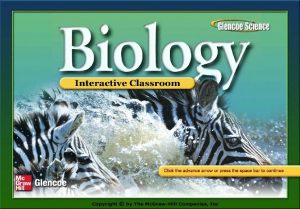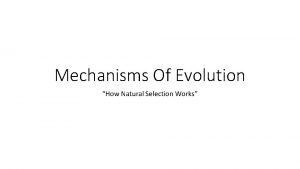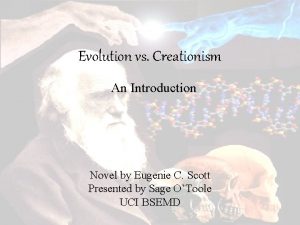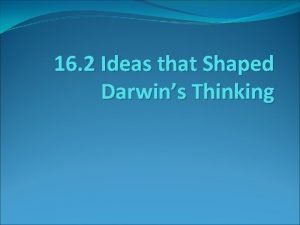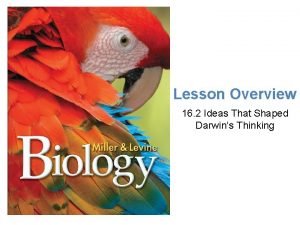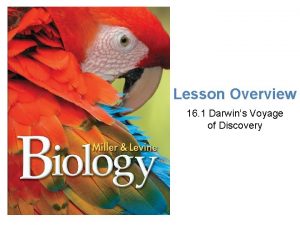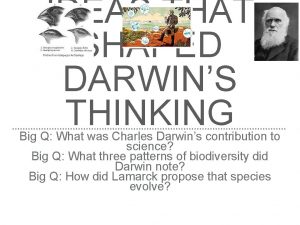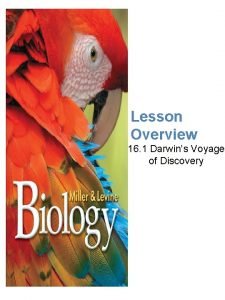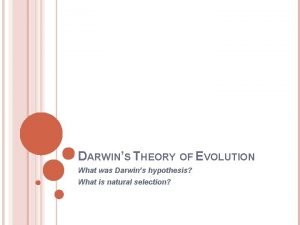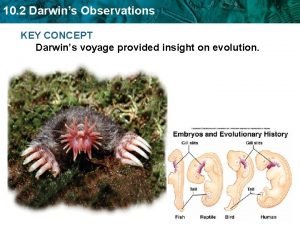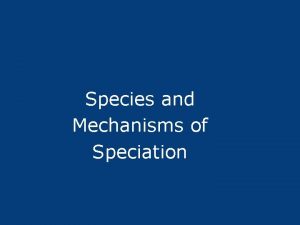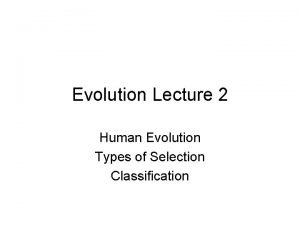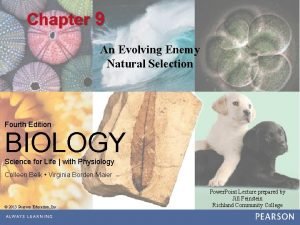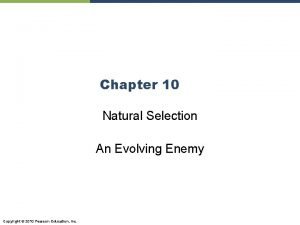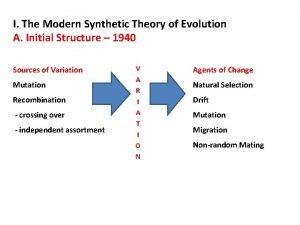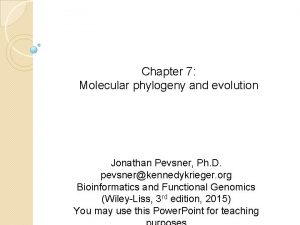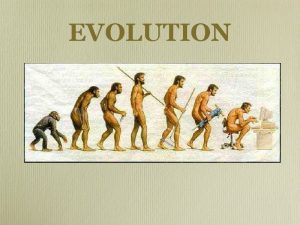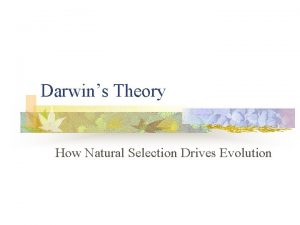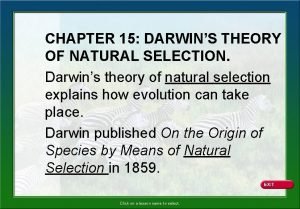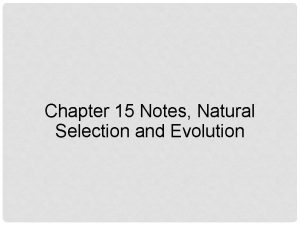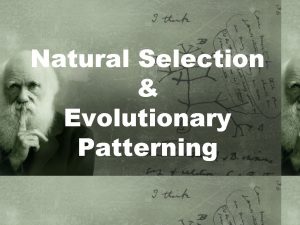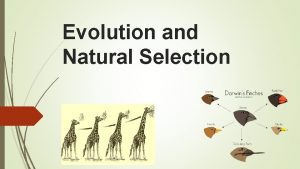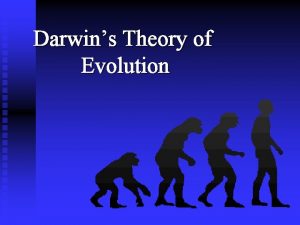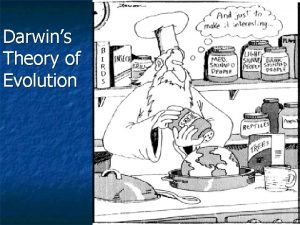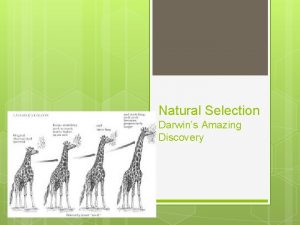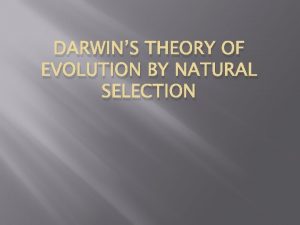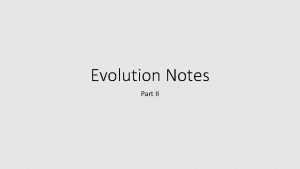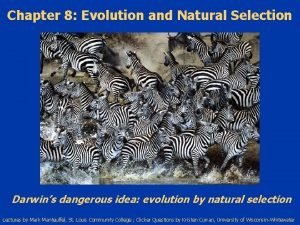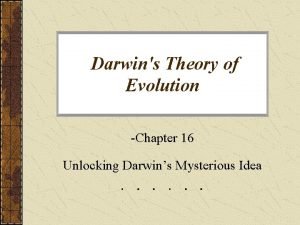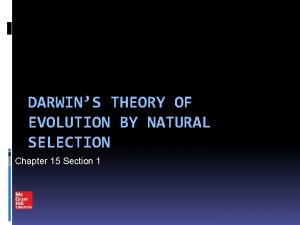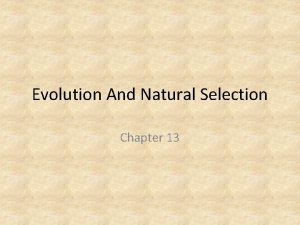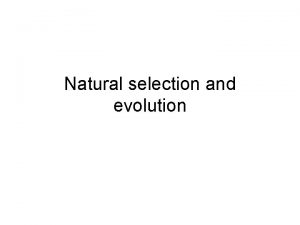Chapter 15 Notes Natural Selection and Evolution DARWINS
































- Slides: 32

Chapter 15 Notes, Natural Selection and Evolution

DARWIN'S VOYAGE In 1831, a young amateur naturalist by the name of Charles Darwin traveled on a ship called the HMS Beagle. On his voyage, he collected specimens of rocks, fossils, animals and plants. Along the voyage, Darwin stopped at an island archipelago called the Galapagos Islands. On the Galapagos Islands, Darwin observed strange creatures like giant tortoises, marine iguanas, and flightless cormorants.

GALAPAGOS ISLANDS

DARWIN'S DISCOVERY As fascinating as these creatures were, it was not these creatures that made Darwin famous. It was actually the discovery of some finches. Initially when Darwin discovered the finches, he thought that each bird was a different kind of bird that was nonrelated to the other birds. After returning to England, Darwin showed his specimens to an Ornithologist who confirmed that the birds were not different kinds of birds, but different varieties of finches.

ARTIFICIAL SELECTION At the time of this discovery, selective breeding was common with domestic breeds of animals. Darwin noticed similarities between the selective breeding of domestic plants and animals and the different varieties of finches that he found. Darwin called the selective breeding of plants and animals artificial selection. Darwin made a hypothesis that something was happening in nature similar to artificial selection but it was occurring naturally rather than by selective breeding man. He called this natural selection.

ARTIFICIAL VERSUS NATURAL SELECTION

NATURAL SELECTION The only thing Darwin needed was a mechanism to explain what caused nature to select for traits without man directing it. Then Darwin noticed that each finch had a unique beak size and shape that assisted them in eating a particular type of food that was most abundant on each particular island. Then he developed his hypothesis to explain the mechanism for natural selection.

MECHANISM FOR NATURAL SELECTION These are the four basic principles Darwin used to explain what causes natural selection to occur. 1) All living things have variety within species. 2) Traits are inherited from parents to offspring. 3) Species compete with one another for limited resources (food, shelter, water, nutrients etc. ). 4) Those individuals that inherit an advantageous trait from their parents will be more fit to survive and therefore reproduce more successfully than the individuals without the trait.

NATURAL SELECTION AND EVOLUTION Darwin published his book On the Origin of Species by Means of Natural Selection in 1859. Darwin also introduced another idea in his book he called theory of evolution. Darwin proposed that if given enough time, small changes in species could produce much larger changes. In other words, he theorized that natural selection could cause evolution.

NATURAL SELECTION AND EVOLUTION Natural selection is not the same thing as evolution. Natural selection produces small changes in populations of organisms to produce new species or varieties of the same species. Natural selection is observable, repeatable, and testable. Evolution is a theory, that attempts to offer an explanation for the origin of all living things. It also suggests that all living organisms share a common ancestor in the past. Because it is something that is believed by some to have happened in the past we can not directly observe it, repeat it, or test it.

EXAMPLE OF NATURAL SELECTION Snowshoe Hare Desert Jackrabbit Cottontail Rabbit

EXAMPLE OF EVOLUTION Black-Capped Chickadee Tyrannosaurus Rex

HOW CAN NEW SPECIES FORM? First of all we have to define what a species is. This is more complex than you may realize. There is the Typological species concept or morphological species concept, which is based on similarities and differences of the physical characteristics of organisms. There is also the Biological species concept which is based on whether or not organisms can interbreed and produce viable and fertile offspring.

WHY USE THE BIOLOGICAL SPECIES CONCEPT? The western meadowlark and eastern meadowlark may look alike and live in overlapping regions, but they have different songs and do not breed with one another. Are they the same species? Most biologists say no. Why? Because they do not breed.

BIOLOGICAL SPECIES CONCEPT Some species can interbreed and have offspring, but their offspring are usually inviable or sterile. Examples of these hybrids between species: mule, zonkey, liger, pizzly or grolar bear, beefalo.

SPECIATION Natural selection cause speciation. Speciation is the separation of one species into two or more species. Speciation usually begins with a genetic drift. When the allele frequencies in a population change or shift it is called a genetic drift. A form of genetic drift that can occur when a small population branches off from a large population is called the founder effect.

THE FOUNDER EFFECT

SPECIATION • There are two common ways that speciation often occurs; allopatric and sympatric speciation. • Allopatric speciation occurs when a population of organisms becomes separated and isolated by a geographical barrier. • A geographical barrier could be a mountain range, a large river, a canyon, a desert etc.

ALLOPATRIC SPECIATION The Abert's squirrel (found on the south rim) and the Kaibab squirrel (found on the north rim) are separated by the Grand Canyon.

SYMPATRIC SPECIATION Sympatric speciation can occur when populations become isolated by ecological factors, instead of geographic barriers. For example different habitats may be occupied, a different niche may be established, or a different resource may be used. Any of these factors could cause genetic drift to occur within a population of organisms living in the same area. Cichlid fish species in Africa's Lake Victoria is a good example of sympatric speciation.

SYMPATRIC SPECIATION

REPRODUCTIVE ISOLATION After speciation occurs, reproductive isolation must occur for a new population of organisms to become a new species. In other words, successful reproduction between two different populations must be prevented. Prezygotic isolation is when allele frequencies change dramatically enough that reproduction between two species becomes unlikely due to reproductive timing, behavior etc. A good example of this is with Pacific Salmon.

REPRODUCTIVE ISOLATION Another way that populations can become reproductively isolated is by postzygotic isolation. Postzygotic isolation is when two organisms can reproduce, but the offspring are sterile or inviable. An example of this is a mule. A donkey's diploid number is 62. A horse's diploid number is 64. A hybrid mule has a diploid number 63, which makes the mule sterile or unable to reproduce. Offspring can also become inviable, or unable to survive or develop normally to reproduce.

THE HARDY WEINBERG PRINCIPLE In 1908, English mathematician Godfrey Hardy and German physician Wilhelm Weinberg developed an equation that explains how allele frequencies remain stable in a population unless acted upon by certain circumstances. Basically, in layman's terms they mathematically demonstrated how natural selection works. The Hardy-Weinberg principle can be written algebraically by the following equation p 2 + 2 pq + q 2 = 1 Or p + q = 1

WHAT ARE THE VARIABLES IN THE HARDY WEINBERG EQUATION?

SO WHAT DOES THE HARDYWEINBERG PRINCIPLE MEAN? Basically, it says that natural selection will not occur unless the following events cause a genetic drift in the allele frequencies. A large population becomes small Immigration or emigration occurs Mating becomes nonrandom A specific trait is selected A mutation occurs

HARDY WEINBERG EQUATION

WHAT ARE THE DIFFERENT TYPES OF NATURAL SELECTION? natural selection will not occur unless certain forces cause selection to occur. Some of these forces can be stabilizing, directional, disruptive, or sexual. Stabilizing selection occurs when the intermediate or average form of a trait is selected. Stabilizing selection operates to eliminate extreme expressions of a trait.

STABILIZING SELECTION

FORCES OF SELECTION Directional selection is when one extreme form of a trait is favored and selected.

FORCES OF SELECTION Disruptive Selection is a type of selection process that selects for two different extremes of a trait and selects against the average trait. In this case, both extremes use mimicry as a camouflage strategy

FORCES OF SELECTION Some forces of selection do not enhance an organism's fitness or ability to survive, but rather advertise an organism's health or dominance. This type of selection is called sexual selection.
 Chapter 15 section 1 darwins theory of natural selection
Chapter 15 section 1 darwins theory of natural selection Chapter 17 darwin's theory of evolution
Chapter 17 darwin's theory of evolution Natural selection definition biology
Natural selection definition biology Types of natural selection in evolution
Types of natural selection in evolution Natural selection vs evolution
Natural selection vs evolution Natural selection vs evolution
Natural selection vs evolution Artificial selection vs natural selection
Artificial selection vs natural selection Natural selection vs artificial selection
Natural selection vs artificial selection Difference between continuous and discontinuous variation
Difference between continuous and discontinuous variation Disruptive selection
Disruptive selection Natural selection vs artificial selection
Natural selection vs artificial selection Section 15-2 ideas that shaped answer key
Section 15-2 ideas that shaped answer key Section 15-2 ideas that shaped darwins thinking
Section 15-2 ideas that shaped darwins thinking Section 2 darwins observations study guide a
Section 2 darwins observations study guide a Ideas that shaped darwin's thinking
Ideas that shaped darwin's thinking Species that vary locally
Species that vary locally Section 15-2 ideas that shaped answer key
Section 15-2 ideas that shaped answer key Darwin's voyage of discovery
Darwin's voyage of discovery Darwin's hypothesis
Darwin's hypothesis Darwins observations
Darwins observations 5 evolution and community ecology
5 evolution and community ecology Two way selection and multiway selection in c
Two way selection and multiway selection in c Two way selection and multiway selection in c
Two way selection and multiway selection in c Mass selection and pure line selection
Mass selection and pure line selection Assortative
Assortative Types of selection in evolution
Types of selection in evolution Natural selection and drug resistance
Natural selection and drug resistance Natural selection and drug resistance
Natural selection and drug resistance Evidence for evolution doodle notes
Evidence for evolution doodle notes Modern synthetic theory of evolution notes
Modern synthetic theory of evolution notes Neutral theory of molecular evolution notes
Neutral theory of molecular evolution notes Lamarck theory of evolution notes
Lamarck theory of evolution notes Evolution of shrm
Evolution of shrm
